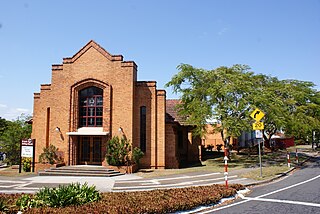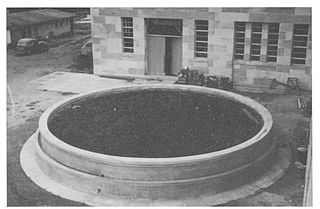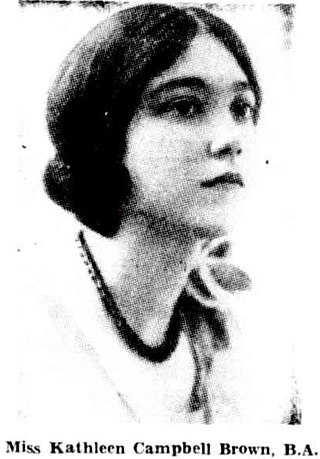Related Research Articles

The Courier-Mail is an Australian newspaper published in Brisbane. Owned by News Corp Australia, it is published daily from Monday to Saturday in tabloid format. Its editorial offices are located at Bowen Hills, in Brisbane's inner northern suburbs, and it is printed at Murarrie, in Brisbane's eastern suburbs. It is available for purchase throughout Queensland, most regions of Northern New South Wales and parts of the Northern Territory.

Toowong is a riverside suburb in the City of Brisbane, Queensland, Australia. In the 2021 census, Toowong had a population of 12,556 people. It is predominantly a middle-class area (67.8%), with a median weekly household income of $1,930.

Taringa is a suburb in the City of Brisbane, Queensland, Australia. In the 2021 census, Taringa had a population of 8,732 people.
James Birrell (1928-2019) was an architect responsible for the design of significant buildings in Queensland, Australia. James Birrell practiced from 1951 to 1986.

Andrew Lang Petrie was a builder, stonemason and politician in Queensland, Australia. He was a Member of the Queensland Legislative Assembly.

The St Lucia Uniting Church is a heritage-listed Uniting church at 7 Hawken Drive, St Lucia, City of Brisbane, Queensland, Australia. Built in 1952, it was designed by Ronald Martin Wilson. The church, formerly known as St Lucia Presbyterian Church, was originally commissioned for the St Lucia congregation of Presbyterians, subsequently becoming the property of the Uniting Church. This church was the first substantial commission awarded to R. Martin Wilson after World War II. The church is listed on the Brisbane Heritage Register.
George Henry Male Addison (1857–1922) was an Australian architect and artist. Many of his buildings are now heritage-listed.

The Church of Saint Ignatius Loyola is a heritage-listed Roman Catholic church at 46 Grove Street, Toowong, City of Brisbane, Queensland, Australia. It was designed by architect Jack Hennessy, junior, and built from 1929 to 1936 by Concrete Construction (QLD) Limited. It was added to the Queensland Heritage Register on 12 July 2005.
Thomas Blair Moncrieff Wightman (1884–1972) was an architect in Queensland, Australia. A number of his works are now heritage-listed.
Hennessy & Hennessy was an architectural firm established in 1912 in Sydney, Australia that was responsible for a series of large scale office buildings in the 1930s in all capital cities in Australia, as well as New Zealand and South Africa, designed by John (Jack) Hennessy (1887–1955), described as Australia's first international architect.

The University of QueenslandSeismology Station was established in 1938 at the University of Queensland, Brisbane, Australia.

Kathleen Campbell-Brown (1903–1996) was a lecturer in French at the University of Queensland for almost 30 years.
Otto Saddler Hirschfeld (1898–1957) was an Australian medical practitioner, academic and university chancellor.

Her Majesty's Theatre was a theatre in Brisbane, Queensland, Australia, between 1888 and 1983. It opened as Her Imperial Majesty's Opera House on 2 April 1888, and was known as His Majesty's Theatre between 1901 and 1952. The largest theatre in Brisbane, it was located at 193 Queen Street. Its façade was in the Italian Renaissance and Corinthian style.
Peter Newell (1916–2010) was an Australian architect, who worked in the modernist tradition in Queensland and became an architectural critic.
Arthur William Forster Bligh (1905-1998) was an Australian architect, who designed a number of Art Deco buildings in Queensland in the twentieth century.
Frank Cullen was an Australian architect, who designed over 200 churches, school, monasteries, convents and other church related buildings in Queensland and Northern New South Wales, Australia
Dance Halls of Brisbane in the twentieth century were popular venues for entertainment, socialising and reflected styles of music, architecture, popular culture and city planning.
Sydney Fancourt McDonald (1885-1947) was an Australian physician and military doctor. He was the first paediatrician within the Faculty of Medicine of the University of Queensland.
Charles Da Costa (1889–1974) was an Australian architect known for his work as a railway architect in Queensland. He specialised in reinforced concrete and structural steel designs.
References
- ↑ "Digital Archive of Queensland Architecture". qldarch.net. Retrieved 1 November 2019.
- 1 2 3 4 5 6 East, John W. (2019). "The Brisbane Architectural Practice of Blackburne and Gzell (1934-1953): A Catalogue of Selected Projects". UQ eSpace. University of Queensland. Retrieved 1 November 2019.
- ↑ "Advertising". Daily Standard (Brisbane, Qld. : 1912 - 1936). 10 September 1935. p. 9. Retrieved 1 November 2019.
- ↑ "DVA's Nominal Rolls". nominal-rolls.dva.gov.au. Retrieved 1 November 2019.
- ↑ "Family Notices". Courier-Mail (Brisbane, Qld. : 1933 - 1954). 30 May 1941. p. 16. Retrieved 1 November 2019.
- ↑ "For Better Homes". Telegraph (Brisbane, Qld. : 1872 - 1947). 1 September 1936. p. 18. Retrieved 1 November 2019.
- 1 2 3 4 5 Bennett, Helen Margaret (2011). Interpreting the Modern: Flatland in Brisbane 1920-1941 Living in Multiple-Occupancy Dwellings in Interwar Brisbane (Griffith thesis thesis). Griffith University.
- ↑ "Bellevue Court | Heritage Places". heritage.brisbane.qld.gov.au. Retrieved 21 December 2019.
- ↑ "Mathers' House | Heritage Places". heritage.brisbane.qld.gov.au. Retrieved 21 December 2019.
- ↑ "MODERN TREND FOLLOWED". Courier-Mail (Brisbane, Qld. : 1933 - 1954). 8 February 1938. p. 18. Retrieved 1 November 2019.
- ↑ "Cupboards give place". Courier-Mail (Brisbane, Qld. : 1933 - 1954). 18 February 1950. p. 7. Retrieved 1 November 2019.
- ↑ "Big building plan started". Sunday Mail (Brisbane, Qld. : 1926 - 1954). 13 June 1948. p. 3. Retrieved 1 November 2019.
- 1 2 "Vitaly Gzell | Modernist Australia" . Retrieved 14 December 2022.
- ↑ "7 Herbert Street, Toowong | Heritage Places". heritage.brisbane.qld.gov.au. Retrieved 21 December 2019.
- ↑ "Mawby residence". qldarch.net. Retrieved 1 November 2019.
- ↑ Macarthur, John, van der Plaat, Deborah, Gosseye, Janina and Wilson, Andrew (2015). Hot modernism: Queensland architecture 1945-1975. Artifice. p. 141. ISBN 9781908967589.
{{cite book}}: CS1 maint: multiple names: authors list (link) - ↑ "Kings Beach - sunshinecoastplaces". www.sunshinecoastplaces.com.au. Retrieved 26 January 2020.
- ↑ "Family Notices". Courier-Mail (Brisbane, Qld. : 1933 - 1954). 31 October 1938. p. 10. Retrieved 1 November 2019.
- ↑ "Vitaly Gzell Architectural drawings - Fryer Manuscripts". manuscripts.library.uq.edu.au. Retrieved 21 December 2019.